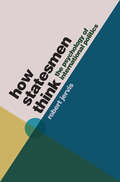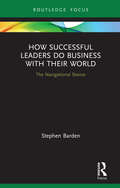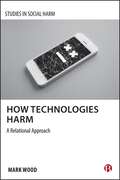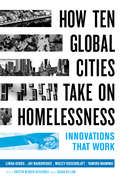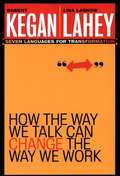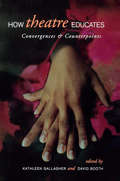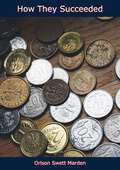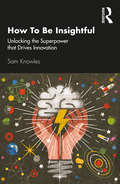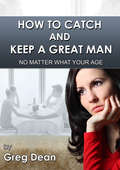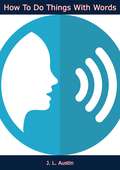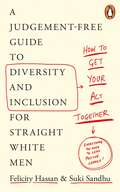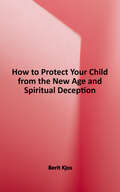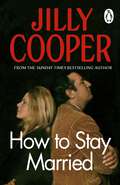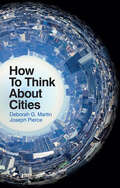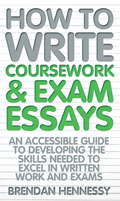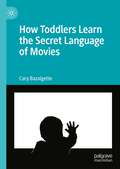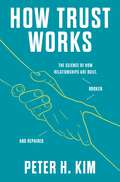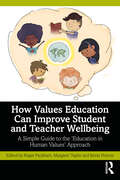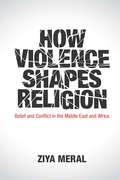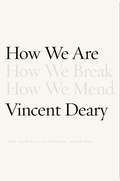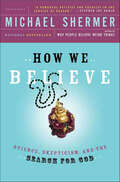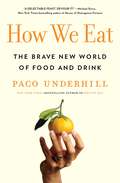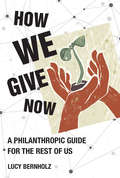- Table View
- List View
How Statesmen Think: The Psychology of International Politics
by Robert JervisRobert Jervis has been a pioneering leader in the study of the psychology of international politics for more than four decades. How Statesmen Think presents his most important ideas on the subject from across his career. This collection of revised and updated essays applies, elaborates, and modifies his pathbreaking work. The result is an indispensable book for students and scholars of international relations.How Statesmen Think demonstrates that expectations and political and psychological needs are the major drivers of perceptions in international politics, as well as in other arenas. Drawing on the increasing attention psychology is paying to emotions, the book discusses how emotional needs help structure beliefs. It also shows how decision-makers use multiple shortcuts to seek and process information when making foreign policy and national security judgments. For example, the desire to conserve cognitive resources can cause decision-makers to look at misleading indicators of military strength, and psychological pressures can lead them to run particularly high risks. The book also looks at how deterrent threats and counterpart promises often fail because they are misperceived.How Statesmen Think examines how these processes play out in many situations that arise in foreign and security policy, including the threat of inadvertent war, the development of domino beliefs, the formation and role of national identities, and conflicts between intelligence organizations and policymakers.
How Successful Leaders Do Business with Their World: The Navigational Stance (Emerging Conversations in Leadership)
by Stephen BardenIn this rigorously researched book Stephen Barden presents compelling evidence that top leaders learn from a very early age to 'do business with the world' by using their power and authority to partner with it, rather than impose themselves on it. Based on interviews with military, corporate and educational leaders, How Successful Leaders Do Business with Their World offers powerful insight into how these findings can be applied in practice. The book illustrates how the assumptions leaders formed as children, and the way they learned to 'make space for themselves', directly links to the way they exercise their leadership as adults. Barden uses these findings and insights, as well as studies from his own corporate leadership career and coaching practice, to describe a set of common assumptions held by successful leaders. The book clearly outlines several key concepts - the Navigational Stance, the Partnering Stance, the Oppositional Stance and the Navigational Compass - illustrates each with relevant examples and makes recommendations for applying these insights in practice. How Successful Leaders Do Business with Their World will be a valuable asset for coaches, leaders, HR and L&D professionals, and all professionals working with leaders.
How Technologies Harm: A Relational Approach (Studies in Social Harm)
by Mark A. WoodTechnologies contribute to harms in a variety of ways, but can we ever say they are harmful in-and-of-themselves? This book offers a new way to understand how technologies, while not intrinsically harmful, are laden with values and dispositions that can contribute to negative outcomes. Building on insights from postphenomenology, realist social theory and the philosophy of action, it provides a framework for examining technology-harm relations: relations with technology that are harmful by virtue of what they contribute to bringing about. It is for anyone seeking to design, regulate, research or simply use technology in a way that prioritizes well-being.
How Ten Global Cities Take On Homelessness: Innovations That Work
by Linda GibbsCreative solutions for global cities addressing their urgent homeless crises. This book takes on perhaps the most formidable issue facing metropolitan areas today: the large numbers of people experiencing homelessnes within cities. Four dedicated experts with first-hand experience profile ten cities—Bogota, Mexico City, Los Angeles, Houston, Nashville, New York City, Baltimore, Edmonton, Paris, and Athens—to explore ideas, strategies, successes, and failures. Together they bring an array of government, nonprofit, and academic perspectives to offer a truly global perspective. The authors answer essential questions about the nature and causes of homelessness and analyze how cities have used innovation and local political coordination to address this pervasive problem. Ten Global Cities will be an invaluable resource not only for students of policy and social work but for municipal, regional, and national policymakers; nonprofit service providers; community advocates and activists; and all citizens who want to collaborate for real change. These authors argue that homelessness is not an insurmountable social condition, and their examples show that cities and individuals working in coordination can lead the charge for better outcomes.
How The Other Half Learns: Equality, Excellence, and the Battle Over School Choice
by Robert PondiscioAn inside look at America's most controversial charter schools, and the moral and political questions around public education and school choice.The promise of public education is excellence for all. But that promise has seldom been kept for low-income children of color in America. In How the Other Half Learns, teacher and education journalist Robert Pondiscio focuses on Success Academy, the network of controversial charter schools in New York City founded by Eva Moskowitz, who has created something unprecedented in American education: a way for large numbers of engaged and ambitious low-income families of color to get an education for their children that equals and even exceeds what wealthy families take for granted. Her results are astonishing, her methods unorthodox.Decades of well-intended efforts to improve our schools and close the "achievement gap" have set equity and excellence at war with each other: If you are wealthy, with the means to pay private school tuition or move to an affluent community, you can get your child into an excellent school. But if you are poor and black or brown, you have to settle for "equity" and a lecture--about fairness. About the need to be patient. And about how school choice for you only damages public schools for everyone else. Thousands of parents have chosen Success Academy, and thousands more sit on waiting lists to get in. But Moskowitz herself admits Success Academy "is not for everyone," and this raises uncomfortable questions we'd rather not ask, let alone answer: What if the price of giving a first-rate education to children least likely to receive it means acknowledging that you can't do it for everyone? What if some problems are just too hard for schools alone to solve?
How The Way We Talk Can Change The Way We Work: Seven Languages for Transformation
by Lisa Laskow Lahey Robert KeganWhy is the gap so great between our hopes, our intentions, even our decisions-and what we are actually able to bring about? Even when we are able to make important changes-in our own lives or the groups we lead at work-why are the changes are so frequently short-lived and we are soon back to business as usual? What can we do to transform this troubling reality? In this intensely practical book, Harvard psychologists Robert Kegan and Lisa Laskow Lahey take us on a carefully guided journey designed to help us answer these very questions. And not just generally, or in the abstract. They help each of us arrive at our own particular answers that can solve the puzzling gap between what we intend and what we are able to accomplish. How the Way We Talk Can Change the Way We Work provides you with the tools to create a powerful new build-it-yourself mental technology.
How Theatre Educates
by Kathleen Gallagher David BoothCanada boasts a remarkable number of talented theatre artists, scholars, and educators. How Theatre Educates brings together essays and other contributions from members of these diverse communities to advocate for a broader and more inclusive understanding of theatre as an educative force.Organized to reflect the variety of contexts in which professionals are making, researching, and teaching drama, this anthology presents a wide range of articles, essays, reminiscences, songs, poems, plays, and interviews to elucidate the relationship between theatre practice and pedagogy, and to highlight the overriding theme: namely, that keeping 'education' - with its curriculum components of dramatic literature and theatre studies in formal school settings - separate from 'theatre' outside of the classroom, greatly diminishes both enterprises.In this volume, award-winning playwrights, directors, actors, and scholars reflect on the many ways in which those working in theatre studios, school classrooms, and on stages throughout the country are engaged in teaching and learning processes that are particular to the arts and especially genres of theatre. Situating theatre practitioners as actors in a larger socio-cultural enterprise, How Theatre Educates is a fascinating and lively inquiry into pedagogy and practice that will be relevant to teachers and students of drama, educators, artists working in theatre, and the theatre-going public.ContributorsMaja ArdalDavid BoothPatricia CanoDiane FlacksKathleen GallagherJohn GilbertSky GilbertJim GilesLinda GriffithsTomson HighwayJanice HladkiCornelia HooglandAnn-Marie MacDonaldLori McDougallJohn MurrellDomenico PietropaoloWalter PitmanRichard RoseJason ShermanLynn SlotkinLarry SwartzJudith ThompsonGuillermo VerdecchiaBelarie Zatzman
How They Succeeded: Life Stories Of Successful Men Told By Themselves (classic Reprint)
by Orison Swett MardenDiscover the timeless secrets of success with Orison Swett Marden’s inspirational classic, "How They Succeeded." This compelling book offers a deep dive into the lives and strategies of some of the most successful individuals of the late 19th and early 20th centuries, providing valuable insights and practical lessons that are as relevant today as they were then.Orison Swett Marden, a pioneering thinker in the field of personal development and self-help, meticulously gathers and presents the stories of remarkable men and women who achieved extraordinary success in their respective fields. Through in-depth interviews and biographical sketches, Marden reveals the principles, habits, and mindsets that propelled these individuals to the pinnacle of their careers."How They Succeeded" features a diverse array of success stories, including entrepreneurs, inventors, writers, and public figures. Marden delves into the lives of icons such as Andrew Carnegie, Thomas Edison, Marshall Field, and many others, uncovering the common threads that connect their journeys to success. Readers will learn about the importance of perseverance, innovation, hard work, and a positive attitude, as well as the role of vision and determination in overcoming obstacles.Marden’s engaging writing style and keen insights make "How They Succeeded" both an informative and motivational read. Each chapter is rich with practical advice and inspirational anecdotes that encourage readers to apply these timeless principles to their own lives. Whether you are an aspiring entrepreneur, a professional looking to advance your career, or someone seeking personal growth, this book offers invaluable guidance and inspiration."How They Succeeded" is not just a collection of success stories; it is a roadmap for achieving excellence and fulfillment in any endeavor. Orison Swett Marden’s work continues to inspire generations of readers to strive for greatness and to believe in the power of their dreams.Join Orison Swett Marden on a journey through the paths of those who have achieved remarkable success, and discover the enduring principles that can help you achieve your own aspirations. "How They Succeeded" is a timeless guide to unlocking your potential and reaching new heights of accomplishment.
How To Be Insightful: Unlocking the Superpower that drives Innovation
by Sam KnowlesHow do we advance? As individuals, families, and businesses? As societies, nations, and a species? In a world where it’s said there is nothing new under the sun, we humans are remarkably resourceful at creating new things. The key to innovation is understanding, but not just by using facts, data, and casual observations. Progress demands the profound and useful understanding of a person or a thing, a situation or an issue. And profound and useful understanding that truly effects change is that most elusive of phenomena: insight. How To Be Insightful provides a novel and deeply practical framework that anyone can use to generate more powerful and impactful insights from the increasing volumes of data we all face every day, whatever we do. The framework – the STEP Prism of Insight – has been developed through decades of both practice and training, and the book includes many exercises designed to help strengthen and develop readers’ insight muscles. The book explains the history, psychology, and neuroscience of insight and includes snapshots of insight from international experts in many different fields – psychology and neuroscience, music and acting, forensic science and market research.
How To Catch and Keep a Great Man No Matter What Your Age
by Greg DeanHow to find, catch and keep an amazing, strong man for and live in a passionate long term love affair.Imagine a life where, no matter what your age, younger or older, you knew the steps to take to not only catch an amazing, gorgeous, strong, secure man, but you had the power to actually keep him solely focused and genuinely, passionately in love with you.Imagine if you could awaken that lost little girl inside to make her come out and play again and have the very best men you meet, turn their heads in awe of your beautiful energy .Forget the advice of other women. Here is the step by step guide by a world renowned, crazy fun, MALE date coach who can tell you exactly what great men want in a woman with absolutely no confusion and zero games.Ordinary men are easy to catch for the sassy girl. But to catch and keep a GREAT man, your perfect man, that requires true mastery in social dynamics for women and you will learn it here.A perfect dating advice book for women.This book will give you step by step instructions from a solid, firm male perspective on how to steal the heart of a great man and live in a passionate relationship the way you did so long ago, making him dote on you, care for you and be your prince.Never satisfied, feeling you cannot meet any great men at your age, whatever that age is? This book will help you end the great drought.Where did all the great men go? They are hiding from YOU. Let's begin this new journey where great men reveal themselves to you once again, giving you the best options in the men you meet, no matter what your age.
How To Do Politics With Art
by Violaine Roussel Anurima BanerjiA major issue in the relation of art to the rest of society is the question of how art penetrates politics. From the perspective of most art scholars, this is a question of aesthetics—whether politics necessarily pollutes and debases the quality of the arts. From the perspective of social science, it has been primarily a question of meaning—how political messages are conveyed through artistic media. Recent work has begun to broaden the study of the arts and politics beyond semiosis and content focus. Several strands of scholarship are converging around the general issue of the social relationships within which art takes political form, that is, how art and artists do politics. This perspective of "doing" moves analysis beyond addressing the meaning of culture, to focus on the ways that art is embedded in—and intervenes in—social relationships, activities, and institutions. This volume brings together an interdisciplinary group of scholars from France and the United States to investigate these directions and themes by exploring the question of "how to do politics with art" from a comparative standpoint, putting sociological approaches in conversation with other disciplinary prisms. It will be of interest to scholars of social movements and politicization, the sociology of art, art history, and aesthetics.
How To Do Things With Words: The William James Lectures Delivered In Harvard University In 1955 (Oxford Paperbacks Ser. #1)
by J. L. AustinJohn L. Austin was one of the leading philosophers of the twentieth century. The William James Lectures presented Austin's conclusions in the field to which he directed his main efforts on a wide variety of philosophical problems. These talks became the classic How to Do Things with Words. For this second edition, the editors have returned to Austin's original lecture notes, amending the printed text where it seemed necessary. Students will find the new text clearer, and, at the same time, more faithful to the actual lectures. An appendix contains literal transcriptions of a number of marginal notes made by Austin but not included in the text. Comparison of the text with these annotations provides new dimensions to the study of Austin's work.—Print ed.
How To Get Your Act Together: A Judgement-Free Guide to Diversity and Inclusion for Straight White Men
by Suki Sandhu Felicity Hassan'Obligatory reading for anyone - straight, white and male or otherwise - who wants to do better but doesn't know where to start.' - People Management'A pivotal guide for going from awareness to action in creating a more diverse and inclusive workplace and society.' - Marc Benioff, CEO of Salesforce--------EVERYTHING YOU NEED TO CREATE AND LEAD AN INCLUSIVE, DIVERSE TEAMThe business case for diversity and inclusion is clear - it drives innovation, profit and employer brand. But how can male white leaders help implement this change? There's no denying it's difficult - perhaps you feel left out of the conversation, afraid to make mistakes, and confused about the evolving language of diversity and inclusion.In this practical guide, leading diversity specialists Felicity Hassan and Suki Sandhu OBE teach you how to create an inclusive environment for your employees and have educated conversations about diversity, navigating what can sometimes be tricky territory with humour and heart.--------'A must-read and a powerful call to seize the opportunity that lies in embracing and celebrating people for who they are.' - Richard Branson, CEO & Founder of The Virgin Group'It takes a good deal of self-awareness and continuous learning to really ingrain the behavioural changes that are needed. This book holds up a mirror and then guides us - skilfully and persuasively - to the actions we all need to be taking.' - Alan Jope, CEO of Unilever
How To Protect Your Child from the New Age and Spiritual Deception
by Berit KjosTempting Voices Beckon to children everywhere. Schools, movies, music, and books all sound the call: "Come, dream, trust Self, you are divine, create your own reality, build a new world. Anything goes, for sin and guilt exist only in the minds of the antiquated 'religious.'" "Unlearning the old ways" is key to this global transformation. Today's assault on biblical Christianity is fast undermining God's moral and spiritual boundaries. It invites chaos rather than unity - coercion instead of freedom - war and violence instead of peace - and ultimately overtakes today's children with the plan to turn them into "progressive" transformation leaders of tomorrow. How can we equip our children so they do not become spiritually deceived and fall into this worldwide agenda? And how can we teach them to have the courage to say no to seductive enticements? There is an answer! We can teach our children to know Truth, so they will discern the counterfeit. And we can teach them how to spot the New Age/New Spirituality and to understand the serious implications that occur when it is embraced.
How To Stay Married
by Jilly Cooper OBE'There is no one else like Cooper' GuardianWhen Jilly Cooper, then a young Sunday Times journalist, was asked to write a book on marriage, she had been married to Leo Cooper for a mere seven years. In this 2011 reissue of that book, they were celebrating their Golden Wedding, and although the institution of marriage has changed a great deal since this book was first written, much of Jilly's advice - frank, fearless, often hilarious, but always wise - still holds good.From the wedding and the honeymoon to life afterwards, including how to deal with the in-laws and how to tell if your other half is having an affair, she dispenses anecdotes, jokes, common sense and endless optimism and fun.Whether you are contemplating marriage, living together, or have been married as long as Jilly and Leo were, you will plenty of good advice and humour in How to Stay Married.Everybody loves Jilly Cooper:'Joyful and mischievous' Jojo Moyes'A delight from start to finish' Daily Mail'Fun, sexy and unputdownable' Marian Keyes'Flawlessly entertaining' Helen Fielding
How To Think About Cities
by Deborah G. Martin Joseph PierceCities are raucous, cacophonous, and complex. Many dimensions of life play out and conflict across cities’ intricate landscapes, be they political, cultural, economic, or social. Urban policy makers and analysts often attempt to “cut through the noise” of urban disagreement by emphasizing a dominant lens for understanding the key, central logic of the city. How To Think About Cities sees this tendency to selective vision as misleading and ultimately unjust: cities are many things at once to different people and communities. This book describes the various ways of seeing the functions and landscapes of the city as place frames, and the constant process of negotiating which place frames best explain the city as place-making. Martin and Pierce call for an explicitly hybrid perspective that shifts between many different frames for making sense of cities. This approach highlights how any given stance opens up some lines of inquiry and understanding while closing off others. Thinking of cities as sites of contested perspectives promotes a synthetic approach to urban analysis that emphasizes difference and political possibility. This mosaic view of the city will be a welcome read for those within urban studies, geography, and social sciences exploring the many faces of urban life.
How To Write Coursework and Exam Essays: An Accessible Guide To Developing The Skills Needed To Excel In Written Work And Exams
by Brendan HennessyWriting good essays is a vital study skill for all stages of education, from GCSE to degree level. This highly successful and thoroughly practical guide leads you step-by-step through the whole process, including: *How to put your ideas into shape * Making your essay coherent and giving it conviction *How to think straight and argue well *How to write a good introduction and conclusion *Improving your style *Editing and rewriting. Now in its 6th edition this book has been thoroughly revised and updated to take account of feedback from teachers and students, incluyding the reqirements of online research. Use the techniques and exercises in this book to develop the originality and good writing that examiners look for - and write essays of distinction every time.
How Toddlers Learn the Secret Language of Movies
by Cary BazalgetteThis book takes a radically new approach to the well-worn topic of children's relationship with the media, avoiding the "risks and benefits" paradigm while examining very young children's interactions with film and television. Bazalgette proposes a refocus on the learning processes that children must go through in order to understand what they are watching on televisions, phones, or iPads. To demonstrate this, she offers unique insight from research done with her twin grandchildren starting from just before they were two years old, with analysis drawn from the field of embodied cognition to help identify minute behaviours and expressions as signals of emotions and thought processes. The book makes the case that all inquiry into early childhood movie-viewing should be based on the premise that learning–usually self-driven–is taking place throughout.
How Trust Works: The Science of How Relationships Are Built, Broken, and Repaired
by Dr. Peter H. KimFrom the world's leading expert on trust repair, a guide to understanding the most essential foundation of our relationships and communities.When our trust is broken, and when our own trustworthiness is called into question, many of us are left wondering what to do. We barely know how trust works. How could we possibly repair it?Dr. Peter H. Kim, the world’s leading expert in the rapidly growing field of trust repair, has conducted over two decades of groundbreaking research to answer that question. In How Trust Works, he draws on this research and the work of other social scientists to reveal the surprising truths about how relationships are built, how they are broken, and how they are repaired. Dr. Kim’s work shows how we are often more trusting than we think and how easily our trust in others can be distorted. He illustrates these insights with accounts of some of the most striking and well-known trust violations that have occurred in modern times and unveils the crucial secrets behind when and why our attempts to repair trust are effective, and which breaches of confidence are just too deep.How Trust Works transforms our understanding of our deepest bonds, giving us the tools to build strong and supportive relationships on every level. With our families, coworkers, and friends. With the groups, organizations, and institutions that touch our lives. And even with societies and nations.
How Values Education Can Improve Student and Teacher Wellbeing: A Simple Guide to the ‘Education in Human Values’ Approach
by Margaret Taplin Roger Packham Kevin FrancisPresenting Values Education as a solution to major challenges in education such as student disengagement and teacher burnout, this book provides a wealth of practical advice about how to implement the Education in Human Values approach in schools, promoting wellness and improved educational outcomes.Values Education is a world-wide movement and comes in several forms. This book explains the need for and nature of values education, provides practical, easy strategies for implementing the Education in Human Values (EHV) approach, and outlines the educational theories that underpin it. The practical strategies in this book can be implemented in small increments in all aspects of school life. The focus is on both student and teacher wellbeing. The methods can also be used by teachers to address their own professional and personal challenges and to help them cope with difficult situations that cannot be changed.Written for teachers, teacher educators, and teachers in training, this book is the one-stop-shop for gaining a better understanding of values education, how it can support whole-school wellbeing and how to implement it effectively.
How Violence Shapes Religion: Belief and Conflict in the Middle East and Africa
by Ziya MeralIs there an inevitable global violent clash unfolding between the world's largest religions: Islam and Christianity? Do religions cause violent conflicts, or are there other factors at play? How can we make sense of increasing reports of violence between Christian and Muslim ethnic communities across the world? By seeking to answer such questions about the relationship between religion and violence in today's world, Ziya Meral challenges popular theories and offers an alternative explanation, grounded on insights inferred from real cases of ethno-religious violence in Africa and the Middle East. The relationship between religion and violence runs deep and both are intrinsic to the human story. Violence leads to and shapes religion, while religion acts to enable violence as well as providing responses that contain and prevent it. However, with religious violence being one of the most serious challenges facing the modern world, Meral shows that we need to de-globalise our analysis and focus on individual conflicts, instead of attempting to provide single answers to complex questions.
How We Are
by Vincent DearyThe first book in a major new trilogy, How to Live: How We Are, How We Break, and How We MendWe live in small worlds. How We Are is an astonishing debut and the first part of the monumental How to Live trilogy, a profound and ambitious work that gets to the heart of what it means to be human: how we are, how we break, and how we mend. In Book One, How We Are, we explore the power of habit and the difficulty of change. As Vincent Deary shows us, we live most of our lives automatically, in small worlds of comfortable routine--what he calls Act One. Conscious change requires deliberate effort, so for the most part we avoid it. But inevitably, from within or without, something comes along to disturb our small worlds--some News from Elsewhere. And with reluctance, we begin the work of adjustment: Act Two. Over decades of psychotherapeutic work, Deary has witnessed the theater of change--how ordinary people get stuck, struggle with new circumstances, and finally transform for the better. He is keenly aware that novelists, poets, philosophers, and theologians have grappled with these experiences for far longer than psychologists. Drawing on his own personal experience and a staggering range of literary, philosophical, and cultural sources, Deary has produced a mesmerizing and universal portrait of the human condition. Part psychologist, part philosopher, part novelist, Deary helps us to see how we can resist being habit machines, and make our acts and our lives more fully our own.
How We Believe: Science, Skepticism, and the Search for God
by Michael ShermerA new edition covering the latest scientific research on how the brain makes us believers or skepticsRecent polls report that 96 percent of Americans believe in God, and 73 percent believe that angels regularly visit Earth. Why is this? Why, despite the rise of science, technology, and secular education, are people turning to religion in greater numbers than ever before? Why do people believe in God at all? These provocative questions lie at the heart of How We Believe , an illuminating study of God, faith, and religion. Bestselling author Michael Shermer offers fresh and often startling insights into age-old questions, including how and why humans put their faith in a higher power, even in the face of scientific skepticism. Shermer has updated the book to explore the latest research and theories of psychiatrists, neuroscientists, epidemiologists, and philosophers, as well as the role of faith in our increasingly diverse modern world.Whether believers or nonbelievers, we are all driven by the need to understand the universe and our place in it. How We Believe is a brilliant scientific tour of this ancient and mysterious desire.
How We Eat: The Brave New World of Food and Drink
by Paco UnderhillAn &“eye-opening&” (Kirkus Reviews) and timely exploration of how our food—from where it&’s grown to how we buy it—is in the midst of a transformation, showing how this is our chance to do better, for us, for our children, and for our planet, from a global expert on consumer behavior and bestselling author of Why We Buy.Our food system is undergoing a total transformation that impacts how we produce, get, and consume our food. Market researcher and bestselling author Paco Underhill—hailed by the San Francisco Chronicle as &“a Sherlock Holmes for retailers&”—reveals where our eating and drinking lives are heading in his &“delectable&” (Michael Gross, New York Times bestselling author of 740 Park) book, How We Eat. In this upbeat, hopeful, and witty approach, How We Eat reveals the future of food in surprising ways. Go to the heart of New York City where a popular farmer&’s market signifies how the city is getting country-fied, or to cool Brooklyn neighborhoods with rooftop farms. Explore the dreaded supermarket parking lot as the hub of innovation for grocery stores&’ futures, where they can grow their own food and host community events. Learn how marijuana farmers, who have been using artificial light to grow a crop for years, have developed a playbook so mainstream merchants like Walmart and farmers across the world can grow food in an uncertain future. Paco Underhill is the expert behind the most prominent brands, consumer habits, and market trends and the author of multiple highly acclaimed books, including Why We Buy. In How We Eat, he shows how food intersects with every major battle we face today, from political and environmental to economic and racial, and invites you to the market to discover more.
How We Give Now: A Philanthropic Guide for the Rest of Us
by Lucy BernholzFrom Go Fund Me to philanthropy: the everyday ways that we can give our money, our time, and even our data to help our communities and seek justice.In How We Give Now, Lucy Bernholz shows that philanthropy is more than writing a check and claiming a tax deduction. For most of us--the non-wealthy givers--philanthropy can be a way of living our values and fully participating in society. We give in all kinds of ways--shopping at certain businesses, canvassing for candidates, donating money, and making conscious choices with our retirement funds. We give our cash, our time, and even our data to make the world a better place. Bernholz takes readers on a tour of the often-overlooked worlds of participatory philanthropy, learning from a diverse group of forty resourceful givers. Donating our digitized personal data is an emerging form of philanthropy, and Bernholz describes safe, equitable, and effective ways of doing so--giving genetic data for medical research through a nonprofit genetics organization rather than a commercial one, for example, or contributing photographs to an online archive like the Densho Digital Repository, which documents America's internment of 120,000 Americans of Japanese descent. Bernholz tells us to "follow the money," however, when we're asked to "add a dollar" to our total at the cash register, or when we buy a charity-branded product; it's more effective to give directly than to give while shopping. Giving is a form of participation. Philanthropy by the rest of us--across geographies and cultural traditions--begins with and builds on active commitment to our communities.
